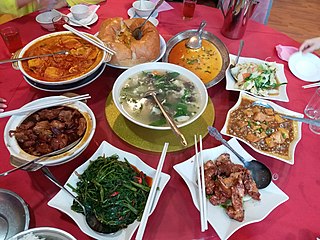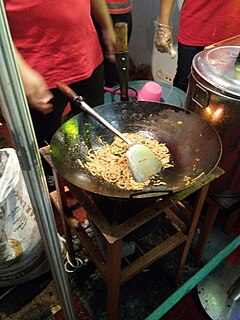
Malaysian cuisine consists of cooking traditions and practices found in Malaysia, and reflects the multi-ethnic makeup of its population. The vast majority of Malaysia's population can roughly be divided among three major ethnic groups: Malays, Chinese and Indians. The remainder consists of the indigenous peoples of Sabah and Sarawak in East Malaysia, the Orang Asli of Peninsular Malaysia, the Peranakan and Eurasian creole communities, as well as a significant number of foreign workers and expatriates.

Malay cuisine is the traditional food of the ethnic Malays of Southeast Asia, residing in modern-day Malaysia, Indonesia, Singapore, Brunei, Southern Thailand and the Philippines as well as Cocos Islands, Christmas Island, Sri Lanka and South Africa.

Cambodian cuisine is an umbrella term for the cuisines of all ethnic groups in Cambodia, whereas Khmer cuisine refers specifically to the cuisine of the Khmer people. Over time, Cambodian cuisine has incorporated elements of Indian, Chinese and more recently French cuisine, and due to some of these shared influences and mutual interaction, it has many similarities with the neighbouring Thai, Vietnamese and Lao cuisines.

The Kadazans are an ethnic group indigenous to the state of Sabah in Malaysia. They are found mainly in Penampang on the west coast of Sabah, the surrounding locales, and various locations in the interior.

Singaporean cuisine derived from several ethnic groups which have developed through centuries of political, economic, and social changes of this cosmopolitan city-state.

Filipino cuisine is composed of the cuisines of more than a hundred distinct ethnolinguistic groups found throughout the Philippine archipelago. A majority of mainstream Filipino dishes that compose Filipino cuisine are from the food traditions of various ethnolinguistic groups and tribes of the archipelago, including the Ilocano, Pangasinan, Kapampangan, Tagalog, Bicolano, Visayan, Chavacano and Maranao ethnolinguistic groups. The style of food making and preparation, and the dishes associated with them, have evolved over many centuries from their Austronesian origins to a mixed cuisine of Chinese, Spanish and American influences, in line with the major waves of influence that had enriched the cultures of the archipelago, as well as others adapted to indigenous ingredients and the local palate.
Mee siam is a dish of thin rice vermicelli of hot, sweet and sour flavours, originated in Penang but popular among the Malay and Peranakan communities throughout out Peninsular Malaysia and Singapore.

Tuaran is the capital of the Tuaran District in the West Coast Division of Sabah, Malaysia. Its population was estimated to be around 105,435 in 2018 with half the population consists of ethnic Dusuns, most of the Lotud ethnic subgroup as well of Bajau descent. The remainder is mostly of the Malaysian Chinese community, particularly from the Hakka subgroup and Malay. The town is bordered on three sides by the Tuaran River. It is located 34 kilometres (21 mi) north of the state capital Kota Kinabalu, and is strategically situated along the main highway linking Kota Kinabalu with the north of Sabah.

Malaysian Chinese cuisine is derived from the culinary traditions of Chinese Malaysian immigrants and their descendants, who have adapted or modified their culinary traditions under the influence of Malaysian culture as well as immigration patterns of Chinese to Malaysia. Because the vast majority of Chinese Malaysians are descendants of immigrants from southern China, Malaysian Chinese cuisine is predominantly based on an eclectic repertoire of dishes with roots from Fujian, Cantonese, Hakka and Teochew cuisines.
The city of Ipoh is the administrative capital of the Malaysian state of Perak and is famous for its cuisine. Its food culture is driven by its majority Chinese population who are largely of Cantonese and Hakka descent. There is also excellent Malay and Indian food in Ipoh; the nasi kandar served by a prominent local Mamak stall is nicknamed nasi ganja due to its supposed addictive properties. Specialty foods from neighbouring towns are also available in Ipoh.

Noodle soup refers to a variety of soups with noodles and other ingredients served in a light broth. Noodle soup is a common dish across East Asia, Southeast Asia and the Himalayan states of South Asia. Various types of noodles are used, such as rice noodles, wheat noodles and egg noodles.

Chinese Indonesian cuisine is characterized by the mixture of Chinese with local Indonesian style. Chinese Indonesians, mostly descendant of Han ethnic Hokkien speakers, brought their legacy of Chinese cuisine, and modified some of the dishes with the addition of Indonesian ingredients, such as kecap manis, palm sugar, peanut sauce, chili, santan and local spices to form a hybrid Chinese-Indonesian cuisine. Some of the dishes and cakes share the same style as in Malaysia and Singapore which are known as the Nonya cuisine by the Peranakan.

Rice vermicelli is a thin form of a noodle. It is sometimes referred to as 'rice noodles' or 'rice sticks', but should not be confused with cellophane noodles, a different Asian type of vermicelli made from mung bean starch or rice starch rather than rice grains themselves.

Peranakan cuisine or Nyonya cuisine comes from the Peranakans, descendants of early Chinese migrants who settled in Penang, Malacca, Singapore and Indonesia, inter-marrying with local Malays. In Baba Malay, a female Peranakan is known as a nonya, and a male Peranakan is known as a baba. The cuisine combines Chinese, Malay, Javanese, South Indian, and other influences.

Javanese cuisine is the cuisine of Javanese people, a major ethnic group in Indonesia, more precisely the province of Central Java, Yogyakarta and East Java.
A great variety of cassava-based dishes are consumed in the regions where cassava is cultivated, and they include many national or ethnic specialities.

Hinava is a traditional native dish of the Kadazan-Dusun people in the state of Sabah. It is made from fish and mixed with lime juice, bird's eye chili, sliced shallots and grated ginger. While the Kadazan are famous with their Hinava tongii.

Betawi cuisine is rich, diverse and eclectic, in part because the Betawi people that create them were composed from numbers of regional immigrants that came from various places in the Indonesian archipelago, as well as Chinese, Indian, Arab, and European traders, visitors and immigrants that were attracted to the port city of Batavia since centuries ago.

Sarawakian cuisine is a regional cuisine of Malaysia. Like the rest of Malaysian cuisine, Sarawak food is based on staples such as rice. There is also a great variety of other ingredients and food preparations due to the influence of the state's varied geography and indigenous cultures quite distinct from the regional cuisines of the Peninsular Malaysia. Sarawak is famous for its multi-ethnic population. As the homeland of many unique communities, Sarawak has a variety of cuisines rarely found elsewhere in Malaysia. The uniqueness of Sarawak well depends on its ethnic groups. Every native group in Sarawak has their own lifestyle, traditions, cultures and also foods. Sarawak cuisine is less spicy and has a subtle in taste. It uses fresh seafood and natural herbs like turmeric, lemongrass, ginger, lime and tapioca leaves. These ingredients are not only easily available, but also add a hint of aroma, texture and freshness to the delicacies. Food is one of the most cultural identities for native groups in Sarawak with each ethnic group having their own delicacies. Among the Iban, popular foods include tubu (stems), tuak and pansuh. The Malay have bubur pedas (porridge) and kek lapis Sarawak ; the Bidayuh have asam siok and sup ponas Bidayuh. The Melanau make tebaloi, sagu and umai and the Orang Ulu are known for garam barrio, kikid (broth), tengayen, and urum giruq (pudding).

Indonesian noodles are a significant aspect of Indonesian cuisine which is itself very diverse. Indonesian cuisine recognizes many types of noodles, with each region of the country often developing its own distinct recipes.


























